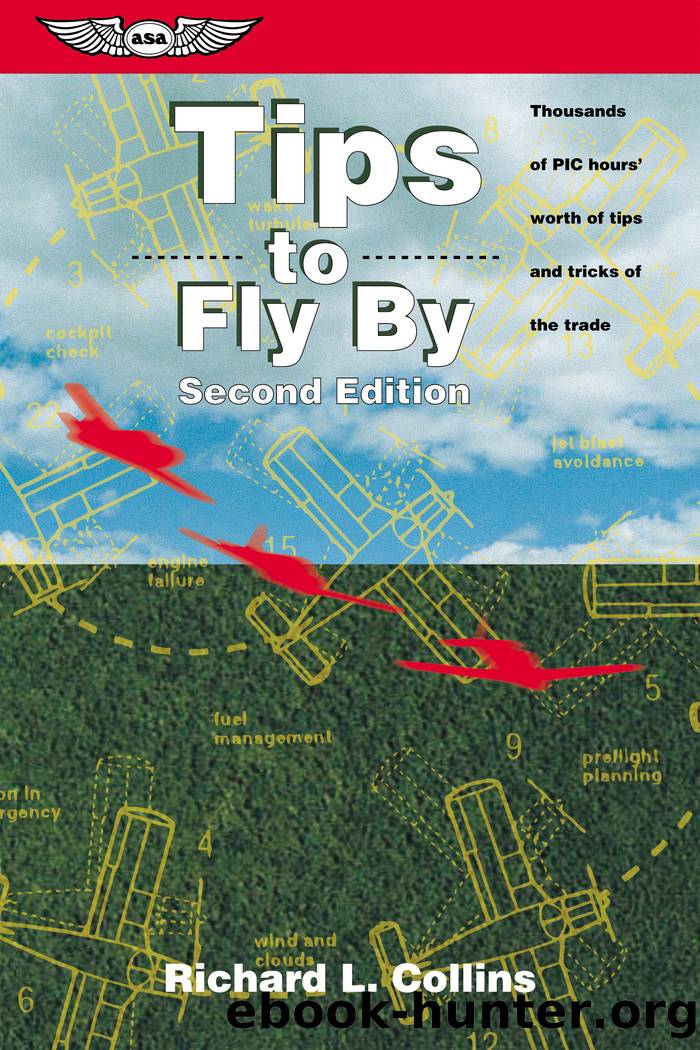Tips to Fly By by Richard L. Collins

Author:Richard L. Collins
Language: eng
Format: epub
Publisher: Aviation Supplies and Academics, Inc.
Published: 2015-01-12T00:00:00+00:00
Practice must cover things we donât ordinarily do with the airplane.
Nothing, not even practice, makes perfect, but practice sure can help us fly better.
To be of real value, practice must cover things that we donât ordinarily do with the airplane. A pilot who drones from here to there IFR on a regular basis doesnât need a lot of straight-and-level hood time. A pilot who spends most of his flying hours doing aerobatics probably doesnât need steep turns. And a pilot who gets his kicks out of shooting landings need not spend much time on touch and goâs. Each must honestly seek out the skills that need improvement through practice. That straight-and-level IFR pilot needs steep turns and unusual attitudes, the aerobat needs hood flying, and the landings specialist probably needs some cross-country workâand the pilot flying a twin needs engine-out experience. Having just left twin operations, letâs start with a discussion of practicing in twins.
First, realistic productive training in multiengine airplanes involves some risk. The airlines learned this the hard way years ago, and an accident involving a large four-engine jet illustrates how and why.
The flight was at night, not unusual for airline training flights. A captain and flight engineer trainee, an instructor up for a proficiency check, and an FAA observer were on board. The weather was good, and the crew asked the tower for permission to take off, circle, and land to the north. This was approved.
As the airplane reached V1 (decision speed), the instructor pulled one of the four engines back to simulate an engine failure. The takeoff continued with no problems. As the aircraft reached an altitude of 1,200 feet, the instructor pulled another engine, on the same side as the first. The trainee was then flying a four-engine jet on two enginesâa situation not unlike flying a light twin on one engine.
The aircraft moved around the traffic pattern at an altitude ranging from 900 to 1,200 feet. Headed east, on base leg, the flaps were lowered to 25 degrees. The instructor was prompting the trainee during this time: ââ¦donât get below 160â¦ball in the middleâ¦whatever it takesâ¦put âer in there nowâ¦â
As the pattern progressed, full flaps were extended by the instructor without command from the trainee. Shortly thereafter the aircraft descended through 650 feet, airspeed 165 knots. From that point, a 2.5-degree descent slope would have resulted in a normal approach to the runway. There was optimism in the cockpit: âOkayâ¦looks goodâ¦now weâre straightened outâ¦â Unfortunately the actual descent angle was three degrees. The aircraft was headed for a point short of the runway. The trainee apparently sensed this and started a correction, but it was with attitude rather than power. The need for power was later recognized, and was applied to the operating engines. A few seconds later, the aircraft started veering to the left, coincident with a sharp reduction in airspeed and, initially, a steep rate of descent.
The instructor called out the airspeed at 135, and six seconds later said, âSee, youâre letting
Download
This site does not store any files on its server. We only index and link to content provided by other sites. Please contact the content providers to delete copyright contents if any and email us, we'll remove relevant links or contents immediately.
| Airport | Commercial |
| Helicopters | History |
| Pictorial | Piloting & Flight Instruction |
| Repair & Maintenance |
Small Unmanned Fixed-wing Aircraft Design by Andrew J. Keane Andras Sobester James P. Scanlan & András Sóbester & James P. Scanlan(32761)
Navigation and Map Reading by K Andrew(5129)
Endurance: Shackleton's Incredible Voyage by Alfred Lansing(4714)
And the Band Played On by Randy Shilts(2162)
The Box by Marc Levinson(1961)
Top 10 Prague (EYEWITNESS TOP 10 TRAVEL GUIDES) by DK(1953)
Wild Ride by Adam Lashinsky(1950)
The Race for Hitler's X-Planes: Britain's 1945 Mission to Capture Secret Luftwaffe Technology by John Christopher(1835)
The One Percenter Encyclopedia by Bill Hayes(1810)
Trans-Siberian Railway by Lonely Planet(1725)
Girls Auto Clinic Glove Box Guide by Patrice Banks(1705)
Bligh by Rob Mundle(1675)
Looking for a Ship by John McPhee(1649)
Good with Words by Patrick Barry(1638)
Batavia's Graveyard by Mike Dash(1628)
TWA 800 by Jack Cashill(1624)
Fighting Hitler's Jets: The Extraordinary Story of the American Airmen Who Beat the Luftwaffe and Defeated Nazi Germany by Robert F. Dorr(1610)
Troubleshooting and Repair of Diesel Engines by Paul Dempsey(1576)
Ticket to Ride by Tom Chesshyre(1564)
